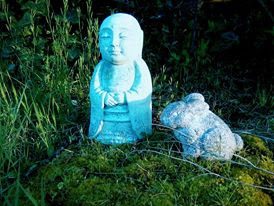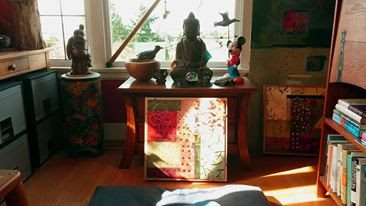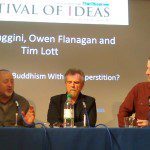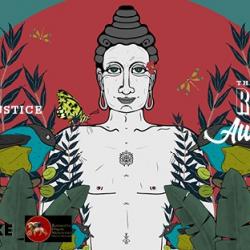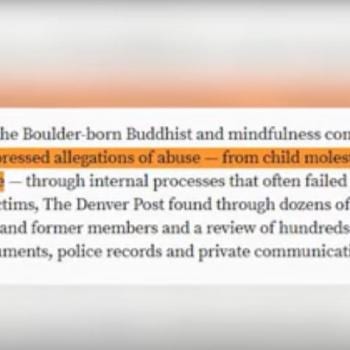A guest-post by Daniel D. Woo (© 2010, 2013, 2014)
As a child I grew up in a family with a father filled with rage, intemperate emotions and verbal abuse and sometimes physical violence. My dad was a former P-51 fighter pilot who flew with the Kuomintang in the Chinese Civil War, where over 80 fellow pilots from my dad’s squadrons died, and where the People’s Republic of China (the Communists) under Chairman Mao Tse-tung won the Civil War.
I knew nothing about post-traumatic stress disorder, the effects of alcohol on anger or the family and culture of my dad’s upbringing. My adaptations in growing up carried on into my career to the point where the very things that made me good at what I did, including litigating and trying cases, were clearly not skillful for living with any sense of contentment, peace, gratitude, acceptance, compassion, empathy, nonjudgmental awareness, tolerance or unconditional love.
At the end of 2002, I decided to learn something about meditation. A few months earlier, I had met a Soto Zen practitioner who had grown up in Chicago and then explored Buddhism in India, Nepal and the US, before settling on a Soto Zen practice here in Washington State. At the time he had been practicing almost 30 years. He said that anyone can develop a skillful mind, and somehow that attracted my attention.
So I made a New Year’s resolution to begin a meditation practice, and in the first two days of January 2003, I looked at many titles in the downtown Seattle Barnes & Noble section on Eastern religions and meditation. I picked one book to start with: Pema Chödrön’s “Comfortable with Uncertainty: 108 Teachings on Cultivating Fearlessness and Compassion.” A short while later, I bought Shunryu Suzuki’s “Zen Mind, Beginner’s Mind.”
I also started attending Seattle Insight Meditation Society’s sittings, and in the intervening years, I’ve visited and sat at a variety of Zen, Insight Meditation Society and Tibetan sanghas, or attended short non-residential retreats.
Mostly I have practiced my own assortment of daily meditation, mindfulness and contemplative practices for over 11 years. I’ve experienced what are for me profound changes in ways I relate to my past, myself, family, friends, acquaintances, strangers and the universe.
Today when I hear internal voices or someone else “screaming” at me, I look immediately for the source inside. Every “screaming scenario” has turned out to be a self-deceiving construct diverting truths about myself and reflecting false projections. Inevitably any impulsive or unwise response or reaction from me amplifies negative energies and my own misery. “I” truly am the source of my own unhappiness.
In over 11 years of continuing practices to become sooner aware of “screaming” scenarios before responding or reacting, everything has changed. Some essential practices for me come from Buddhist teachings. Practice itself cultivates skillful means of conscious action or non-action and teaches that whatever internal pain comes up is neither inevitable nor inescapable.
Two years after I began meditation, mindfulness and other practices, an analogy came up from my childhood. I grew up with vinyl records where if there is a deep enough scratch, the record player needle would hit the scratch, bounce back and start over again until it hit the scratch again and do this over and over again into infinity. The only solution was to lift up and put down the needle after the scratch to play the rest of the recording.
Over time in and after meditations, I learned to be silent until I heard the rustling of leaves and grasses, the rain, the humming in rooms, the beating of wings and hearts, the heat rising from sun-baked stones, claws, pads and footsteps on pavement, earth, sand, the air cooling and warming, the sounds of life, the movement of everything, until the moments came when the sounds of my own thoughts fade – and at such moments, the needle would be lifted, the player dissolved and the music that is always here could be heard.
I understood over time that what I had been unconsciously holding on to were the scratches, the stuck needles, the distorted sounds, the players and the recordings and that none of these were real. I discovered that it is in letting go, everything enters.
These practices point to a way of peaceful living inside that is no longer held hostage to anger or fear with whatever may happen in life. Continuing practices resulted for me in momentary insights – which when recognized, inspired more practice. The changes themselves are like flashes of light in a dark room. The entire room may not be lit up but the flashes disclose some truths.
The internal insights are not merely a matter of intellectually understanding of words or concepts as better ideas of living. The flashes of light are life itself.
Shantideva (Sk:Śāntideva) was an 8th-century Indian Buddhist scholar at Nālandā University in Bihar, India. Shantideva explained how to cultivate and expand compassion and wisdom in the classic and enduring The Way of the Bodhisattva. One of the translations of this work is from the Padmakara Translation Group, and it was published by Shambhala in 2008. Chapter 6 offers verses on patience. They speak to what today I term “screaming scenarios.”
Here are a few of the verses on patience:
“1. All the good works gathered in a thousand ages,
Such as deeds of generosity,
And offerings to the Blissful Ones –
A single flash of anger shatters them.2. No evil is there similar to anger,
No austerity to be compared with patience.
Steep yourself, therefore, in patience,
In various ways, insistently.3. Those tormented by the pain of anger,
Never know tranquility of mind –
Strangers they will be to every pleasure,
They will neither sleep nor feel secure.”“24.Never thinking, ‘Now I will be angry,’
People are impulsively caught up in anger.
Irritation, likewise, comes
Though never plans to be experienced!”“33.Thus, when enemies or friends
Are seen to act improperly,
Remain serene and call to mind
That everything arises from conditions.”
I have also learned from the Buddhist Mettā bhāvanā practices (the cultivation of loving-kindness).
“Mettā (Pāli:मेत्ता) or maitrī (Sanskrit) has been translated as ‘loving-kindness, ’‘friendliness,’ ‘benevolence,’ ‘amity,’ ‘friendship,’ ‘good will,’ ‘kindness,’ ‘love,’ ‘sympathy,’ and ‘active interest in others.’… The object of mettā meditation is lovingkindness (without Upādāna, that is, attachment). Traditionally, the practice begins with the meditator cultivating loving kindness towards themselves, then their loved ones, friends, teachers, strangers, enemies, and finally towards all sentient beings. Commonly, it can be used as a greeting or closing to a letter or note.’
“Mettā signifies friendship and non-violence as well as ‘a strong wish for the happiness of others’, but also less obvious or direct qualities such as showing patience, receptivity, and appreciation. Though it refers to many seemingly disparate ideas, Mettā is in fact a very specific form of love – a caring for another independent of all self-interest – and thus is likened to one’s love for one’s child or parent. Understandably, this energy is often difficult to describe in words; however, in the practice of Mettā meditation, one recites specific words and phrases in order to evoke this ‘boundless warm-hearted feeling.’ The strength of this feeling is not limited to or by family, religion, or social class. Indeed, Mettā is a tool that permits one’s generosity and kindness to be applied to all beings and, as a consequence, one finds true happiness in another person’s happiness, no matter who the individual is.”
[Excerpts are from Wikipedia: http://https://en.wikipedia.org/wiki/Mettā.]
When I began Mettā practices in very early January 2003, I wanted to make sure that I took time for these practices early in the morning. Our sons had to catch a school bus before 7 am each morning so after they were fed and I washed the dishes, I would wash and shave under the shower. As I did so, I spent most of the time going through Mettā practices, using specific individuals whom I knew personally as examples for each step. I did this for 18 months before the practices became “second nature” for me.
I’ve learned during this time that I never should skip beginning with myself, for it is to the extent that I harbor grudges against myself, am I unable to offer acceptance and kindness to others. I begin with the following words for myself, then extend them to a person I love, a person I like, a neutral person, a person I dislike, a person I “hate” and cannot conceivably forgive, and finally all sentient beings.
I use something like the following for each phase of the practice (substituting the words “you” or “all sentient beings” as appropriate for the different stages of the practice):
May I be filled with loving-kindness.
May I be safe from inner and outer dangers.
May I be well in body and mind.
May I be at ease and happy.
Another practice that I’ve incorporated comes from Tibetan tonglen (the Great Compassion or “sending and receiving” meditations). Tonglen is a practice of accepting wholeheartedly (1) on the in-breath whatever unease, anger, fear or other difficult emotion or condition that I may be experiencing in the moment and expanding that acceptance of the same emotions and conditions that all sentient beings may be experiencing at the same moment, and (2) on the out-breath, transmitting a wish that all sentient beings be free in that moment of such emotion or condition.
In January 2003 I started my tonglen practices. Tonglen is paradoxically opposed to how I had reacted to pain, discontent, fear, anger or other afflictive emotions before beginning the practice.
In October 2003, I had an extremely severe and acute episode with back spasms where I could not stand straight, sit, lie, walk, or be in any position without creating more back spasms. Episodic acute back spasms occurred yearly after I had a back injury in 1991, and I had developed chronic back pain with a swollen area near a lower disc in my back. I hobbled to a quiet room where I decided to practice tonglen for the severe pain that I was experiencing. On each in-breath, I surrendered to and simultaneously accepted my back pain and also asked to take into myself the same kind of back pain from all living beings. On each out-breath, I asked that all living beings be relieved of the same kind of back pain. I lost track of time. I heard a giant “pop” and at the same moment, I felt a complete release in my back. I was freed of the acute pain although my back had some soreness. Since then, I no longer have chronic back pain and only on 2 or 3 occasions have I suffered any acute back spasms.
The release of pain was a complete surprise for me. I was not practicing tonglen to be relieved of pain. I thought that my attitude toward pain might change – not that the pain itself would leave me.
This and other experiences inform me that most of my experiential pain doesn’t really exist – instead, my own responses, reactions and relationship to and rejection of pain are what create seemingly unbearable pain.
Another practice comes from a teaching by the Buddha. Beginning in 2003 and until mid-2004, I kept by my workstation the following variation of the Buddha’s words (which I had found in a Zen calendar):
“People with opinions go around bothering other people.”
These words were for me a constant reminder to practice neither rejecting nor struggling with what other people said (whether in person, phone calls, emails, texts or other communications or media) or with phantom conversations taking place in my own thoughts. Instead I was to catch myself before responding or reacting. I was to practice pausing and to reflect and contemplate whether I may be adding anything useful, wise or timely at any moment, and I wait. This quote was also a reminder that “who” I am is not a collection of my opinions.
In effect I was learning patience through this practice. I was developing what some Buddhist teachers call the “Sacred Pause” during which I can learn not to add to suffering – whether it is my own or that of another living being.
After about 16 months, I did not need to keep the quote on a piece of paper near me. The words are engraved in my mind. Today when I am bothered by another’s opinion and either immediately want to respond or react, I recognize that I create a wall around myself and close off what this moment already provides, if I do not practice the Sacred Pause.
Another Buddhist teaching is about “Deep Listening” or “Generous Listening” practices. These practices in effect continue the development of the Sacred Pause and can be mindfully adopted in every listening situation (whether with one person or a group of people). For me, I incorporate the “bare awareness of breath” practices from the Four Foundations of Mindfulness (the Satipaṭṭhāna Sutta), to stop when I am distracted, trying out responses or arguments or otherwise distracted by or focused on whatever problems I might be conjuring up in my mind, and instead to come back to the present moment, with bare awareness of breath, and to start listening again right then.
This practice by itself helps open me up to what someone is actually saying from the heart and I’ve learned through the patience developed during this practice, how often some insight or other learning could be heard when my mind is quieter and I am hearing.
It is through these past 11 years of experiences that I now interpret in my own life what the disease of the mind is as described in the opening verses of the Hsin Hsin Ming (“Verses on the Faith Mind” by the Third Cha’n (Zen) Patriarch Chien-chih Seng-ts’an (about 606 AD):
“The Great Way is not difficult
for those who have no preferences.
When love and hate are both absent
everything becomes clear and undisguised.
Make the smallest distinction, however,
and heaven and earth are set infinitely apart.
If you wish to see the truth
then hold no opinions for or against anything.
To set up what you like against what you dislike
is the disease of the mind.
When the deep meaning of things is not understood
the mind’s essential peace is disturbed to no avail.
The Way is perfect like vast space
where nothing is lacking and nothing is in excess.
Indeed, it is due to our choosing to accept or reject
that we do not see the true nature of things.
Be serene in the oneness of things
and such erroneous views will disappear by themselves.”
I am not suggesting that only one set of practices is the only or best way to the insights I’ve experienced. To the contrary there are teachings in faiths, paths, traditions and religions of all kinds that can allow for such changes and I’ve been learning also from other spiritual paths and practices.
For example, it is in the practices that I’ve described here where I learned the simple wisdom of what the shaman don Miguel Ruiz describes as “The Second Agreement” in his “The Four Agreements”; he says:
“Don’t Take Anything Personally.”
“Nothing others do is because of you. What others say and do is a projection of their own reality, their own dream. When you are immune to the opinions and actions of others, you won’t be the victim of needless suffering.”
It took until sometime in 2004, when I recognized the insanity of the idea that I can read anyone’s mind. This specific realization came when I realized this was even true with my wife’s mind. I stopped trying to do so. Since the moment I stopped trying to read her mind, our relationship began to improve. (We’ve been married over 42 years as of this date in 2014.)
In 2005, a client and I met over lunch to discuss his business agenda. He was wound-up, distracted, angry, snappy and rude. Rather than contracting and closing off, I asked whether something had happened in his life. He told me that his brother had drowned a few days earlier, and he talked for the next two hours about the impact on his parents and the grief and anger he was feeling. We did not return to the business reason for the meeting.
In 2009, a former colleague (who is an intense workaholic and always self-preoccupied) asked me to help out on a legal project. When I saw him in a conference room at his firm’s offices, he was angry and loudly swearing about a different project. Rather than contracting from him and wishing that I was somewhere else with someone else, I silently practiced Mettā and tonglen meditations for him – to allow him to regain and experience some space. Eventually he quieted down. (This is one of many occasions where in comparing past encounters, I could see that my past reactions to such incidents amplified the other person’s tension, anger, fear or other negative emotions.)
In 2011, my dad died. I experienced a complete forgiveness of all that was in the past when I went to the hospital and saw my dad, a dying man in a hospital bed. Over the next 10+ weeks, I would visit and sit with him with one purpose only – to help him die in peace. When he struggled with pain while trying to sleep, I practiced Mettā and tonglen while holding his hand. Whenever I did this, he slept more peacefully. I learned during these weeks that patience is intertwined with forgiveness and love.
I have reinforced my faith in continuing practice with everything – on the mat, in a grocery waiting line, in traffic, with family, friends, strangers, easy and difficult people, washing dishes, emptying the trash, writing bills, walking, typing, reading, on the phone, with myself, and even in dream states when sleeping.
During these years of practice, I am losing conventional notions of sanity. What I once considered normal and sane ways to respond, react or relate to screaming and other difficult scenarios no longer appear sane. In a sense a tremendous volume of “noise” just stops with practice. Many transitions of change that once were very difficult are simpler today.
I am learning that when we accept things as they are, right now and here, our hearts comprehend that we are complete and perfect in this moment. When we forgive what we think we are, right now and here, we understand that incompleteness is perfection. Neither do we have to escape nor fight. Time ceases. We return to a natural state of spaciousness and from such, our intuition will guide us for the right response – whether of action or restraint, with what is within or before us. We can enjoy a moment of liberation and happiness and joy follow.
Dan Woo is a lawyer who has for over 36 years represented creative, innovative companies and individuals, in the arts, software publishing, medical technologies and other fields. Dan has also seen much suffering in the imperfections of conflict resolution in the US legal system.

